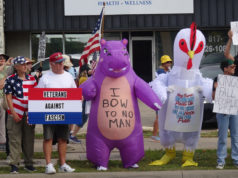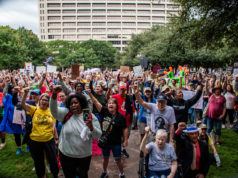TCEQ has also consistently opposed EPA’s handling of ozone, one of six compounds with federal air standards. Ozone is created primarily by fossil fuel emissions and is known to exacerbate respiratory and cardiovascular disease. Exhaustive reviews by EPA scientists and independent agency advisors have urged that the federal standard, now 75 parts per billion, be made stricter.
In November, the EPA proposed a new standard of 65 to 70 ppb, which the agency predicted would prevent thousands of premature deaths and asthma-related emergency room visits each year.

Just minutes after that announcement, TCEQ issued a press release in which Commission Chairman Bryan Shaw called the decision “shortsighted.”
A lowered standard would create serious problems for Texas’ three largest cities — Houston, San Antonio, and Dallas — which are out of compliance with the current standard.
Honeycutt has criticized the EPA’s ozone science at public hearings, in comments to EPA’s ozone panel, in presentations at scientific conferences, and in his own scientific analyses on TCEQ’s website.
In TCEQ’s October newsletter, he said his agency’s “in-depth review” of the EPA’s scientific analysis found that “further lowering of the ozone standard will fail to provide any measurable increase in human health protection.”
“The fervor with which they’ve been critical of the ozone standard … is unprecedented,” said Craft, the Environmental Defense Fund scientist. “I can’t think of another state where they’ve spent the amount of time and resources on this issue as Texas.”
Last year, TCEQ paid Gradient, a Massachusetts-based consulting firm, $1.65 million to examine the science behind EPA’s air-quality standards, including ozone. Clawson, the TCEQ spokesman, recently told the Texas Tribune that the agency is developing a separate Gradient contract to “provide a comprehensive review” of the science “addressing potential impact of ozone on asthma.”
One of Honeycutt’s main objections to EPA science is that it’s based on an eight-hour ozone exposure. He thinks the standard should be weakened because people are rarely outside for that long.
The problem with that reasoning, Craft said, is that some people, including construction workers, do spend most of their day outside. “And what if someone wanted to stay outside all day? I think most people want the option of being able to go outside and feel like you’re breathing air that is healthy.”
Another of Honeycutt’s arguments relies on a 2009 study that projects a few dozen more deaths in Houston if the ozone standard is tightened. Those results were based on the assumption that Houston would use a particular cleanup strategy that targets only one class of ozone-forming chemicals, Craft said. TCEQ can avoid the problem by choosing a different plan, she said.
Robert Haley, an epidemiologist at the University of Texas Southwestern Medical Center, grappled with TCEQ’s position on ozone last year when he was lobbying for the shutdown of three coal-fired power plants that contribute to the ozone problem in Dallas. Haley is a member of the Dallas County Medical Society, which has petitioned for the closures.
Haley spoke with each of the TCEQ commissioners in back-to-back meetings and said Honeycutt sat in on all of them. The commissioners “all deferred to him, [saying] ‘He is our expert.’…
“They consult him on everything,” Haley said.
Not long after those meetings, TCEQ denied the petition.
“It does no one any good to go and require reducing ozone if we’re not having a beneficial impact,” Shaw said during the petition hearing. “And there’s data … that suggests that [reducing] ozone may not be giving us that benefit.”
********
TCEQ’s critics say the agency’s industry-friendly ESLs are just part of the air-quality problem in Texas. The bigger problem, they say, is that violations of the ESLs don’t necessarily trigger regulatory action.
The Texas guidelines are “just a number that they picked, and they said that when the air pollution monitors hit that number, then they would investigate further,” said Marks, the former Houston environmental director. “There was no actual consequence to finding the air quality was above that particular number.”
It’s hard to tell when or how TCEQ enforces the ESLs.
The agency’s toxicology website says that if airborne concentrations “exceed the screening levels [ESLs], it does not necessarily indicate a problem but rather triggers a review in more depth.”
The website also says ESLs are only used to screen companies that apply for air permits and should not be used to gauge outdoor air quality. TCEQ has a separate set of health-based guidelines to evaluate air-monitoring data, and those numbers can be up to three times less protective than the ESLs.
But even when these more lenient numbers are exceeded, TCEQ doesn’t necessarily see a health risk.
When InsideClimate News asked TCEQ what happens when air-monitoring data exceed guidelines, spokeswoman Andrea Morrow said the data are examined on a case-by-case basis. For example, she said, if an air monitor showed 5,000 ppb of a chemical with a TCEQ guideline of 1,000 ppb, the toxicology department would say “there is a potential for adverse health effects.”
In other words, even a number five times the TCEQ guideline doesn’t automatically trigger enforcement action.
InsideClimate News then asked if the agency had ever penalized or shut down a facility for violating ESLs or air-monitoring guidelines. Clawson, the spokesman, said TCEQ “does not collect and track information on enforcement actions” in a way that would enable him to answer that question. To get that information, he said, it would be necessary to examine individual investigation reports.
When Honeycutt was asked if he thought the ESLs should be turned into legally enforceable standards, he said that decision rests with the Texas Legislature. A 2007 House bill that aimed to do that never made it out of committee.
Honeycutt defended the way his agency reacts when guidelines are exceeded. He said TCEQ puts neighborhoods or regions with elevated chemical levels on an Air Pollutant Watch List. The agency then dedicates more resources to improving air quality in those areas, perhaps by investigating local industries or doing additional air monitoring.
“We don’t just note [the problem] and go on with our lives,” Honeycutt said. “We do do something about it.”
But being added to the list doesn’t guarantee a speedy solution.
In 1998, a neighborhood in Corpus Christi was placed on the list because annual benzene concentrations exceeded TCEQ’s 1.0 ppb guideline. The neighborhood was removed from the list 12 years later, in 2010 — not because the annual benzene average had dropped below that level, but because the agency had weakened the guideline to 1.4 ppb.
The agency’s website cited the new guideline as the reason for the delisting.
This story is part of a larger series, “Big Oil, Bad Air,” a joint project of the Center for Public Integrity and InsideClimate News. It is reprinted with permission.












Welcome to hell, Republican style.
TECQ chief toxicologist, Michael Honeycutt, tells us that there’s nothing bad about ozone alert days. We should just stay inside. We can’t go for a walk, ride a bike, watch our grandchildren play soccer, or work in our gardens. We just have to stay inside and be grateful that Texas lets industry pollute our air.
DFW is the second worst area of the entire USA for ozone pollution.
1200 people die every year in the Dallas – Fort Worth area from ozone poisoning.